Material Analysis of Early Medieval Woven Bands from Gródek upon the Bug River and Pień, Poland
Abstract
1. Introduction
2. Materials and Methods
3. Results and Discussion
3.1. Raw Material and Structure
3.2. Metal Threads
3.3. Deterioration of the Bands
3.4. Dyes and HPLC-UV-Vis-ESI-MS/MS Analysis
3.5. Radiocarbon Dating
4. Conclusions
Supplementary Materials
Author Contributions
Funding
Institutional Review Board Statement
Informed Consent Statement
Data Availability Statement
Conflicts of Interest
Abbreviations
| ABA | Acid–Base–Acid treatment |
| Ag2S | Silver sulphide |
| AgCl | Silver chloride |
| BP | Before Present |
| CE | Common Era |
| DAD | Diode Array Detector |
| dMRM | Dynamic Multiple Reaction Monitoring |
| DMSO | Dimethyl sulfoxide |
| EDS | Energy-Dispersive X-ray Spectroscopy |
| HPLC | High-Performance Liquid Chromatography |
| MS | Mass Spectrometry |
| SEM | Scanning Electron Microscope |
| UV | Ultraviolet radiation |
| Vis | Visible radiation |
| VWD | Variable Wavelength Detector |
References
- Geijer, A. Birka: Untersuchungen und Studien. Die Textilfunde aus den Gräbern; Almqvist & Wiksell: Stockholm, Sweden, 1938; Volume 3. [Google Scholar]
- Saburova, M.A. Drevnerusskiy kostyum [Old Russian costume]. In Drevnyaya Rus’. Byt i kul’tura [Ancient Russia. Everyday Life and Culture]; Kolchin, B.A., Маkаrovа, T.I., Eds.; Nauka: Moscow, Russia, 1997; pp. 93–109. [Google Scholar]
- Woodfin, W.T.; Rassamakin, Y.; Holod, R. Foreign vesture and nomadic identity on the Black Sea littoral in the early thirteenth century: Costume from the Chungul Kurgan. Ars. Orient. 2010, 38, 155–186. [Google Scholar]
- Kuśnierz, J. Gródek upon the Bug River, site 1A. The results of the excavations in the years 1952–1955. Cemetery at the ward of the stronghold. In The Early Medieval Settlement Complex at Gródek upon the Bug River in the Light of Results from Past Research (1952–1955) [Wczesnośredniowieczny Zespół Osadniczy w Gródku nad Bugiem w Świetle Wyników Badań Dawnych (1952–1955)]; Wołoszyn, M., Ed.; Leibniz-Institut für Geschichte und Kultur des östlichen Europa: Leipzig, Germany; Instytut Archeologii i Etnologii Polskiej Akademii Nauk: Warsaw, Poland; Instytut Archeologii Uniwersytetu Rzeszowskiego: Rzeszów, Poland, 2018; Volume 4, pp. 699–734. [Google Scholar]
- Janeczek, A. The Territorial Organization in Western Rus’ between High and Late Middle Ages [Organizacja terytorialna zachodnich ziem Rusi pomiędzy pełnym i późnym średniowieczem]. In From Cherven’ Towns to Curzon Line: The Lands on the Middle Bug During the Middle Ages and the Historiographic Perspective on the Formation of Poland’s Eastern Border, the 18th–21st Century; Wołoszyn, M., Ed.; Leibniz-Institut für Geschichte und Kultur des östlichen Europa: Leipzig, Germany; Instytut Archeologii i Etnologii Polskiej Akademii Nauk: Warsaw, Poland; Instytut Archeologii Uniwersytetu Rzeszowskiego: Rzeszów, Poland, 2017; Volume 1, pp. 107–157. [Google Scholar]
- Wołoszyn, M. Finding the frontiers of the Commonwealth. In Revisiting the Byzantine Commonwealth: Nodes, Networks, and Spheres; Shepard, J., Frankopan, P., Eds.; Oxford Academic: Oxford, UK, 2025; pp. 535–556. [Google Scholar]
- Grupa, M. Tkaniny z cmentarzyska w Pniu, gm. Dąbrowa Chełmińska [Textiles from burial site in Pień, Dąbrowa Chełmińska commune]. In Wczesnośredniowieczne i Nowożytne Cmentarzysko w Pniu [Early Medieval and Early Modern Burial Site in Pień]; Poliński, D., Ed.; Wydawnictwo Edukacyjne “Akapit“, Jagielloński Instytut Wydawniczy, Europejska Fundacja Pamięć i Dziedzictwo: Toruń, Poland, 2020; pp. 367–382. [Google Scholar]
- Drozd, A.; Janowski, A.; Poliński, D. Wczesnośredniowieczne groby komorowe na cmentarzysku w Pniu koło Bydgoszczy: (badania 2005–2007). In XVI Sesja Pomorzoznawcza, Szczecin, 22–24 listopada 2007 r. Cz. 1: Od Epoki Kamienia do Okresu Wczesnośredniowiecznego; Janowski, A., Kowalski, K., Słowiński, S., Eds.; Stowarzyszenie Naukowe Archeologów Polskich Oddział: Szczecin, Poland, 2009; pp. 351–366. [Google Scholar]
- Poliński, D. Wczesnośredniowieczne i Nowożytne Cmentarzysko w Pniu [Early Medieval and Early Modern Burial Site in Pień]; Wydawnictwo Edukacyjne “Akapit“, Jagielloński Instytut Wydawniczy, Europejska Fundacja Pamięć i Dziedzictwo: Toruń, Poland, 2020. [Google Scholar]
- Wouters, J. High performance liquid chromatography of anthraquinones: Analysis of plant and insect extracts and dyed textiles. Stud. Conserv. 1985, 30, 119–128. [Google Scholar] [CrossRef]
- Indictor, N.; Koestler, R.J.; Blair, C.; Wardwell, A.E. The evaluation of metal wrappings from medieval textiles using scanning electron microscopy-energy dispersive X-ray spectrometry. Text. Hist. 1988, 19, 3–22. [Google Scholar] [CrossRef]
- Wouters, J.; Verhecken, A. The coccid insect dyes: Hplc and computerized diode-array analysis of dyed yarns. Stud. Conserv. 1989, 34, 189–200. [Google Scholar] [CrossRef]
- Wouters, J.; Verhecken, A. The Scale Insect Dyes (Homoptera: Coccoidea). Species Recognition by HPLC and Diode-Array Analysis of the Dyestuffs. Ann. Société Entomol. Fr. (N.S.) 1989, 25, 393–410. [Google Scholar] [CrossRef]
- Gillard, R.D.; Hardman, S.M.; Thomas, R.G.; Watkinson, D.E. The mineralization of fibres in burial environments. Stud. Conserv. 1994, 39, 132–140. [Google Scholar] [CrossRef]
- Cork, C.R.; Wild, J.P.; Cooke, W.D.; Fang-Lu, L. Analysis and Evaluation of a Group of Early Roman Textiles from Vindolanda, Northumberland. J. Archaeol. Sci. 1997, 24, 19–32. [Google Scholar] [CrossRef]
- Good, I. Archaeological Textiles: A Review of Current Research. Annu. Rev. Anthropol. 2001, 30, 209–226. [Google Scholar] [CrossRef]
- Cybulska, M.; Jedraszek-Bomba, A.; Kuberski, S.; Wrzosek, H. Methods of Chemical and Physicochemical Analysis in the Identification of Archaeological and Historical Textiles. Fibres Text. East. Eur. 2008, 16, 67–73. [Google Scholar]
- Cybulska, M. Analysis and Visualization of Historical Textiles for the Needs of Museum Conservation and Exhibition. In Handbook of Museum Textiles; Scrivener Publishing: Beverly, MA, USA, 2022; pp. 283–302. [Google Scholar]
- Margariti, C.; Lukesova, H.; Gomes, F.B. Advanced Analytical Techniques for Heritage Textiles. Herit. Sci. 2024, 12, 388. [Google Scholar] [CrossRef]
- Müller, M.; Murphy, B.; Burghammer, M.; Snigireva, I.; Riekel, C.; Gunneweg, J.; Pantos, E. Identification of single archaeological textile fibres from the cave of letters using synchrotron radiation microbeam diffraction and microfluorescence. Appl. Phys. A 2006, 83, 183–188. [Google Scholar] [CrossRef]
- Cho, L.-L. Identification of textile fiber by Raman microspectroscopy. Forensic Sci. J. 2007, 6, 55–62. [Google Scholar]
- Houck, M.M. Identification of Textile Fibers; Woodhead Publishing: Cambridge, UK, 2009. [Google Scholar]
- Hugan, E.; Holst, B. Determining the fibrillar orientation of bast fibres with polarized light microscopy: The modified Herzog test (red plate test) explained. J. Microsc. 2013, 252, 159–168. [Google Scholar] [CrossRef]
- Lukešová, H.; Palau, A.S.; Holst, B. Identifying plant fibre textiles from Norwegian Merovingian Period and Viking Age graves: The Late Iron Age Collection of the University Museum of Bergen. J. Archaeol. Sci. Rep. 2017, 13, 281–285. [Google Scholar] [CrossRef]
- Adar, F. A Simple Introduction to Raman Spectral Identification of Organic Materials. Spectroscopy 2021, 36, 8–15. [Google Scholar] [CrossRef]
- Weiszburg, T.G.; Gherdán, K.; Ratter, K.; Zajzon, N.; Bendő, Z.; Radnóczi, G.; Takács, Á.; Váczi, T.; Varga, G.; Szakmány, G. Medieval Gilding Technology of Historical Metal Threads Revealed by Electron Optical and Micro-Raman Spectroscopic Study of Focused Ion Beam-Milled Cross Sections. Anal. Chem. 2017, 89, 10753–10760. [Google Scholar] [CrossRef]
- Geminiani, L.; Campione, F.P.; Corti, C.; Motella, S.; Rampazzi, L.; Recchia, S.; Luraschi, M. Unveiling the Complexity of Japanese Metallic Threads. Heritage 2021, 4, 4017–4039. [Google Scholar] [CrossRef]
- Šimić, K.; Soljačić, I.; Mudronja, D.; Petrović Leš, T. Metal Content and Structure of Textiles in Textile Metal Threads in Croatia from 17th to 20th Century. Materials 2022, 15, 251. [Google Scholar] [CrossRef]
- Śliwka-Kaszyńska, M.; Cybulska, M.; Drążkowska, A.; Kuberski, S.; Karczewski, J.; Marzec, A.; Rybiński, P. Multi-Analytical Techniques for the Study of Burial Clothes of Polish King Sigismund III Vasa (1566–1633) and His Wife Constance Habsburg (1588–1631). Molecules 2024, 29, 192. [Google Scholar] [CrossRef]
- Grömer, K.; Coletti, F.; Gomes, F.B.; Saunderson, K. Understanding Gold Textiles: Case Studies of Gold Threads from the Bronze Age and Antiquity in Europe. In Textile Crossroads: Exploring European Clothing, Identity, and Culture Across Millennia; Droß-Krüpe, K., Quillien, L., Sarri, K., Eds.; Zea Books: Lincoln, NE, USA, 2024; pp. 101–117. [Google Scholar]
- Lech, K.; Pawlak, K.; Jarosz, M. Mass spectrometry in identification of color components of natural organic dyestuffs used in art. Chem. Anal. 2008, 53, 479–509. [Google Scholar]
- Lech, K.; Połeć-Pawlak, K.; Jarosz, M. Characterization of Organic Natural Dyes by Electrospray Mass Spectrometry Coupled with HPLC and/or Capillary Electrophoresis. In Organic Mass Spectrometry in Art and Archaeology; John Wiley & Sons, Ltd.: Hoboken, NJ, USA, 2009; pp. 363–388. [Google Scholar]
- Petroviciu, I.; Vanden Berghe, I.; Cretu, I.; Albu, F.; Medvedovici, A. Identification of natural dyes in historical textiles from Romanian collections by LC-DAD and LC-MS (single stage and tandem MS). J. Cult. Herit. 2012, 13, 89–97. [Google Scholar] [CrossRef]
- Lech, K.; Witkos, K.; Wilenska, B.; Jarosz, M. Identification of unknown colorants in pre-Columbian textiles dyed with American cochineal (Dactylopius coccus Costa) using high-performance liquid chromatography and tandem mass spectrometry. Anal. Bioanal. Chem. 2015, 407, 855–867. [Google Scholar] [CrossRef]
- Otłowska, O.; Slebioda, M.; Kot-Wasik, A.; Karczewski, J.; Sliwka-Kaszynska, M. Chromatographic and Spectroscopic Identification and Recognition of Natural Dyes, Uncommon Dyestuff Components, and Mordants: Case Study of a 16th Century Carpet with Chintamani Motifs. Molecules 2018, 23, 339. [Google Scholar] [CrossRef]
- Shahid, M.; Wertz, J.; Degano, I.; Aceto, M.; Khan, M.I.; Quye, A. Analytical methods for determination of anthraquinone dyes in historical textiles: A review. Anal. Chim. Acta 2019, 1083, 58–87. [Google Scholar] [CrossRef] [PubMed]
- Lech, K. Dataset supporting the identification of natural dyes in yellow, orange, brown and green fibres from Krakow liturgical vestments. Data Brief. 2020, 31, 105735. [Google Scholar] [CrossRef]
- Lech, K.; Fornal, E. A Mass Spectrometry-Based Approach for Characterization of Red, Blue, and Purple Natural Dyes. Molecules 2020, 25, 3223. [Google Scholar] [CrossRef]
- Sabatini, F.; Bacigalupo, M.; Degano, I.; Javér, A.; Hacke, M. Revealing the organic dye and mordant composition of Paracas textiles by a combined analytical approach. Herit. Sci. 2020, 8, 122. [Google Scholar] [CrossRef]
- Lech, K.; Nawała, J.; Popiel, S. Mass Spectrometry for Investigation of Natural Dyes in Historical Textiles: Unveiling the Mystery behind Safflower-Dyed Fibers. J. Am. Soc. Mass. Spectrom. 2021, 32, 2552–2566. [Google Scholar] [CrossRef]
- Tamburini, D.; Dyer, J.; Cartwright, C.; Green, A. Changes in the production materials of Burmese textiles in the nineteenth century—Dyes, mordants and fibres of Karen garments from the British Museum’s collection. Herit. Sci. 2023, 11, 150. [Google Scholar] [CrossRef]
- Serafini, I.; Ciccola, A.; Curini, R.; Favero, G.; Kavich, G.M.; Cleland, T.P.; Solazzo, C. Revealing the Unknown: How Multi-technical Approach Can Be Crucial in Identification of Dyes and Protein in Archeological Remains. In Multidisciplinary Approaches for the Investigation of Textiles and Fibres in the Archaeological Field; Coletti, F., Margariti, C., Forte, V., Spantidaki, S., Eds.; Springer Nature: Cham, Switzerland, 2024; pp. 71–122. [Google Scholar]
- Lech, K. Analysing reds in Coptic textiles: Insights from mass spectrometry. J. Cult. Herit. 2025, 71, 274–281. [Google Scholar] [CrossRef]
- Poulin, J.; Veall, M.-A.; Paulocik, C. Identification of Shellfish Blue on an Ancient Egyptian (Dynasty XVIII) Painted Votive Textile. Heritage 2025, 8, 257. [Google Scholar] [CrossRef]
- Czajka, A.; Lech, K.; Nasiłowska, I.A.; Wachowska, G.; Wagner, B. From the Archives: Chemical Study of Royal Seal Cords using Mass Spectrometric Techniques. ChemPlusChem 2025, 90, e202500098. [Google Scholar] [CrossRef] [PubMed]
- Frei, K.M.; Skals, I.; Gleba, M.; Lyngstrøm, H. The Huldremose Iron Age textiles, Denmark: An attempt to define their provenance applying the strontium isotope system. J. Archaeol. Sci. 2009, 36, 1965–1971. [Google Scholar] [CrossRef]
- Karjalainen, V.-P.; Finnilä, M.A.J.; Salmon, P.L.; Lipkin, S. Micro-computed tomography imaging and segmentation of the archaeological textiles from Valmarinniemi. J. Archaeol. Sci. 2023, 160, 105871. [Google Scholar] [CrossRef]
- Cybulska, M.; Marciniak, M.; Sielski, J. The early medieval textile finds from Gródek upon the Bug River. An analysis of materials, manufacturing techniques and origin. In The Early Medieval Settlement Complex at Gródek upon the Bug River in the Light of Results from Past Research (1952–1955) [Wczesnośredniowieczny Zespół Osadniczy w Gródku nad Bugiem w Świetle Wyników Badań Dawnych (1952–1955)]; Wołoszyn, M., Ed.; Leibniz-Institut für Geschichte und Kultur des östlichen Europa: Leipzig, Germany; Instytut Archeologii i Etnologii Polskiej Akademii Nauk: Warsaw, Poland; Instytut Archeologii Uniwersytetu Rzeszowskiego: Rzeszów, Poland, 2018; Volume 4, pp. 751–815. [Google Scholar]
- Oraltay, R.G.; Karadag, R. Surface Investigation of Metal Threads and Solid Metals of Ottoman Textiles in the Topkapi Palace Museum. Stud. Conserv. 2020, 65, 59–64. [Google Scholar] [CrossRef]
- Lech, K. Universal analytical method for characterization of yellow and related natural dyes in liturgical vestments from Krakow. J. Cult. Herit. 2020, 46, 108–118. [Google Scholar] [CrossRef]
- Hajdas, I.; Cristi, C.; Bonani, G.; Maurer, M. Textiles and Radiocarbon Dating. Radiocarbon 2014, 56, 637–643. [Google Scholar] [CrossRef]
- Hajdas, I.; Guidobaldi, G.; Haghipour, N.; Wyss, K. Characterization and Choice of Treatment for Accurate Radiocarbon Analysis—Insights from the ETH Laboratory. Radiocarbon 2024, 66, 1152–1165. [Google Scholar] [CrossRef]
- Němec, M.; Wacker, L.; Gäggeler, H. Optimization of the Graphitization Process at Age-1. Radiocarbon 2010, 52, 1380–1393. [Google Scholar] [CrossRef]
- Synal, H.-A.; Stocker, M.; Suter, M. MICADAS: A new compact radiocarbon AMS system. Nucl. Instrum. Methods Phys. Res. Sect. B Beam Interact. Mater. At. 2007, 259, 7–13. [Google Scholar] [CrossRef]
- Sun, Z.; Ramsay, J.; Guay, M.; Ramsay, B. Enhanced yield of medium-chain-length polyhydroxyalkanoates from nonanoic acid by co-feeding glucose in carbon-limited, fed-batch culture. J. Biotechnol. 2009, 143, 262–267. [Google Scholar] [CrossRef] [PubMed]
- Reimer, P.J.; Austin, W.E.N.; Bard, E.; Bayliss, A.; Blackwell, P.G.; Bronk Ramsey, C.; Butzin, M.; Cheng, H.; Edwards, R.L.; Friedrich, M.; et al. The IntCal20 Northern Hemisphere Radiocarbon Age Calibration Curve (0–55 cal kBP). Radiocarbon 2020, 62, 725–757. [Google Scholar] [CrossRef]
- Monnas, L.; Crill, R.; Desrosiers, S.; Gilbert, R.; Granger-Taylor, H.; Miller, L.; Pritchard, F. Vocabulary of Technical Terms, Elnglishwith Translation of the Terms into French, German, Italian, Portuguese, Spanish and Swedish; Centre International d’étude des Textiles Anciens: Lyon, France, 2021. [Google Scholar]
- Járó, M.; Tóth, A. Scientific identification of European metal thread manufacturing techniques of the 17–19th centuries. Endeavour 1991, 15, 175–184. [Google Scholar] [CrossRef]
- Karatzani, A. Metal threads: The historical development. In Textiles and Dress in Greece and the Roman East: A Technological and Social Approach; Tzachili, I., Zimi, E., Eds.; Ta Pragmata Publications: Athenes, Greece, 2012; pp. 55–68. [Google Scholar]
- Rogerson, C.; Garside, P. Instrumental analysis of metal threads as an aid for interpretation and preservation of a fifteenth-century tapestry altar frontal and super frontal. In Tapestry Conservation: Principles and Practice; Lennard, F., Hayward, M., Eds.; Routledge: London, UK, 2005; pp. 49–56. [Google Scholar]
- Cybulska, M.; Kuberski, S.; Maik, J.; Orlińska-Mianowska, E. Figural embroidery from Tum Collegiate Church–analysis, reconstruction and identification. In NESAT XI. The North European Symposium for Archaeological Textiles XI, 10–13 May 2011 in Esslingen am Neckar; Banck-Burgess, J., Nübold, C., Eds.; VML Verlag Marie Leidorf: Rahden, Germany, 2013; pp. 10–13. [Google Scholar]
- Geijer, A. A History of Textile Art; Sotheby Parke Bernet: London, UK, 1979. [Google Scholar]
- Cybulska, M.; Maik, J. Archaeological Textiles: A Need for New Methods of Analysis and Reconstruction. Fibres Text. East. Eur. 2007, 15, 185–189. [Google Scholar]
- Huisman, D.J. Degradation of Archaeological Remains; SDU Uitg: Den Haag, The Netherlands, 2009. [Google Scholar]
- Gutarowska, B.; Pietrzak, K.; Machnowski, W.; Milczarek, J.M. Historical textiles—A review of microbial deterioration analysis and disinfection methods. Text. Res. J. 2017, 87, 2388–2406. [Google Scholar] [CrossRef]
- Mazzoli, R.; Pessione, E. Ancient Textile Deterioration and Restoration: Bio-Cleaning of an Egyptian Shroud Held in the Torino Museum. In Microorganisms in the Deterioration and Preservation of Cultural Heritage; Joseph, E., Ed.; Springer International Publishing: Cham, Switzerland, 2021; pp. 199–216. [Google Scholar]
- Anheuser, K.; Roumeliotou, M. Characterisation of mineralised archaeological textile fibres through chemical staining. Conserv. 2003, 27, 23–33. [Google Scholar] [CrossRef]
- Zheng, H.; Yang, H.; Zhang, W.; Yang, R.; Su, B.; Zhao, X.; Zhou, Y.; Dai, X. Insight of silk relics of mineralized preservation in Maoling Mausoleum using two enzyme-linked immunological methods. J. Archaeol. Sci. 2020, 115, 105089. [Google Scholar] [CrossRef]
- Chave, A.; Reynaud, C.; Anheim, É.; Iacconi, C.; Bertrand, L. Studying archaeological mineralised textiles. A perspective from sixteenth to nineteenth century scholars. J. Cult. Herit. 2024, 66, 304–315. [Google Scholar] [CrossRef]
- Wanhill, R.J.H. Brittle Archaeological Silver Identification, Restoration and Conservation; NLR Technical Publication NLR TP 97647 L; National Aerospace Laboratory NLR: Amsterdam, The Netherlands, 2000; pp. 30–35. [Google Scholar]
- Marchand, G.; Guilminot, E.; Lemoine, S.; Rossetti, L.; Vieau, M.; Stephant, N. Degradation of archaeological horn silver artefacts in burials. Herit. Sci. 2014, 2, 5. [Google Scholar] [CrossRef]
- Mohamed, W.; Rifai, M.; El Zahraa Sadat, F. Corrosion off Metal Threads in-Situ: Case Study. IJISET Int. J. Innov. Sci. Eng. Technol. 2016, 3, 661–666. [Google Scholar]
- Duran, A.; Perez-Maqueda, R.; Perez-Rodriguez, J.L. Degradation processes of historic metal threads used in some Spanish and Portuguese ornamentation pieces. J. Cult. Herit. 2019, 36, 135–142. [Google Scholar] [CrossRef]
- Martyka, K.; Lech, K. Badania kolorystyki tekstyliów ze średniowiecznego cmentarzyska pruskiego w Równinie Dolnej (pow. kętrzyński). Pomorania Antiq. 2024, XXXIII, 239–268. [Google Scholar]
- Hofenk de Graaff, J.H. The Colorful Past: Origins, Chemistry and Identification of Natural Dyestuffs; Archetype Publications Ltd.: London, UK, 2004. [Google Scholar]
- Cardon, D. Natural Dyes: Sources, Tradition, Technology and Science; Archetype: London, UK, 2007. [Google Scholar]
- Vanden Berghe, I.; Mannering, U.; Rimstad, C. New dye analyses of Danish Viking Age textiles from Bjerringhøj, Hvilehøj and Hedeby. J. Archaeol. Sci. Rep. 2023, 49, 103965. [Google Scholar] [CrossRef]
- Ford, L.; Rayner, C.M.; Blackburn, R.S. Degradation of lucidin: New insights into the fate of this natural pigment present in Dyer’s madder (Rubia tinctorum L.) during the extraction of textile artefacts. Dye. Pigment. 2018, 154, 290–295. [Google Scholar] [CrossRef]
- Munro, J. The Anti-Red Shift—To the Dark Side: Colour Changes in Flemish Luxury Woollens, 1300–1550. In Medieval Clothing and Textiles; Netherton, R., Owen-Crocker, G.R., Eds.; The Boydell Press: Woodbridge, VA, USA, 2007; Volume 7, pp. 55–96. [Google Scholar]
- Jacoby, D. Cypriot Gold Thread in Late Medieval Silk Weaving and Embroidery. In Deeds Done Beyond the Sea: Essays on William of Tyre, Cyprus and the Military Orders Presented to Peter Edbury; Edgington, S.B., Nicholson, H.J., Eds.; Routledge: London, UK, 2014; pp. 101–114. [Google Scholar]
- Monnas, L. “Gold of Cyprus” and other gold threads in late medieval England, 1300–1450. In Crusading and Trading Between West and East: Studies in Honour of David Jacoby; Menache, S., Kedar, B.Z., Balard, M., Eds.; Routledge: London, 2019; pp. 289–305. [Google Scholar]
- Abu-Reidah, I.M.; Contreras, M.M.; Arráez-Román, D.; Segura-Carretero, A.; Fernández-Gutiérrez, A. Reversed-phase ultra-high-performance liquid chromatography coupled to electrospray ionization-quadrupole-time-of-flight mass spectrometry as a powerful tool for metabolic profiling of vegetables: Lactuca sativa as an example of its application. J. Chromatogr. A 2013, 1313, 212–227. [Google Scholar] [CrossRef] [PubMed]
- Hajdas, I.; Bonani, G.; Thut, J.; Leone, G.; Pfenninger, R.; Maden, C. A report on sample preparation at the ETH/PSI AMS facility in Zurich. Nucl. Instrum. Methods Phys. Res. Sect. B Beam Interact. Mater. At. 2004, 223–224, 267–271. [Google Scholar] [CrossRef]
- Goslar, T. Raport z Wykonania Datowań C–14 w Poznańskim Laboratorium Radiowęglowym (The Report of the C–14 Dating Analyses Conducted at the Poznań Radiocarbon Laboratory); Archive of the Institute of Archaeology at Nicolaus Copernicus University in Toruń, Poland: Toruń, Poland, 2008. [Google Scholar]
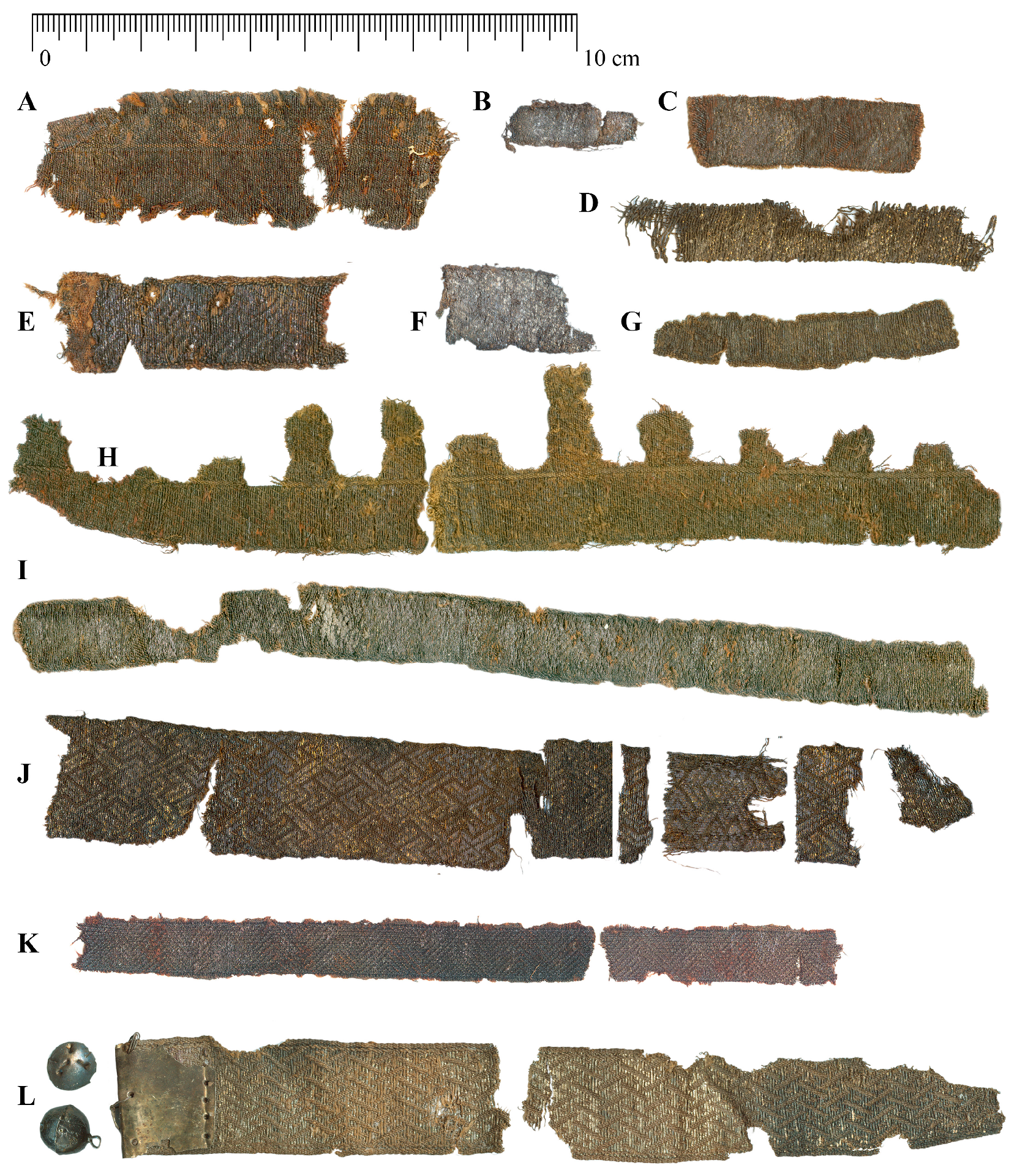
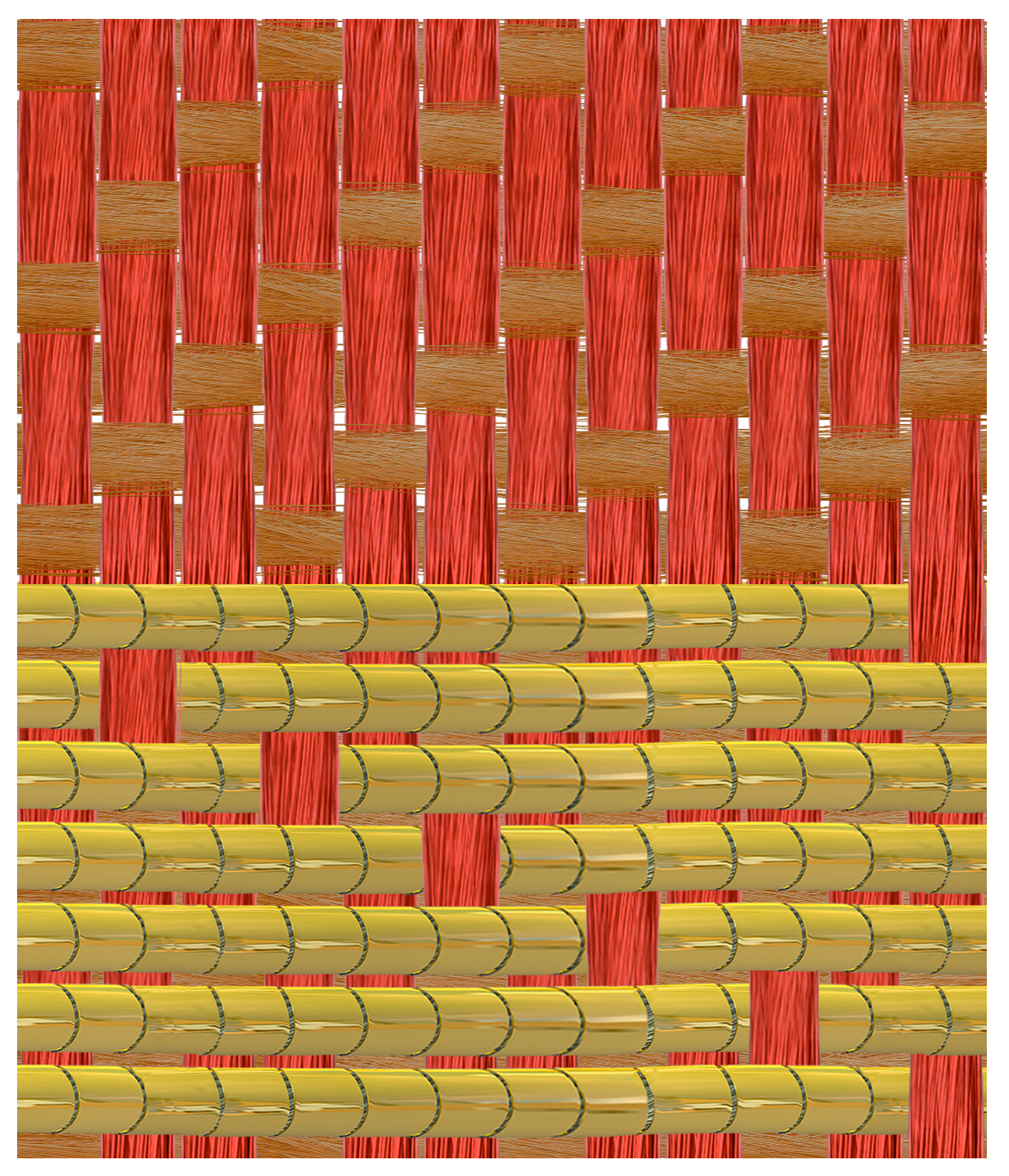
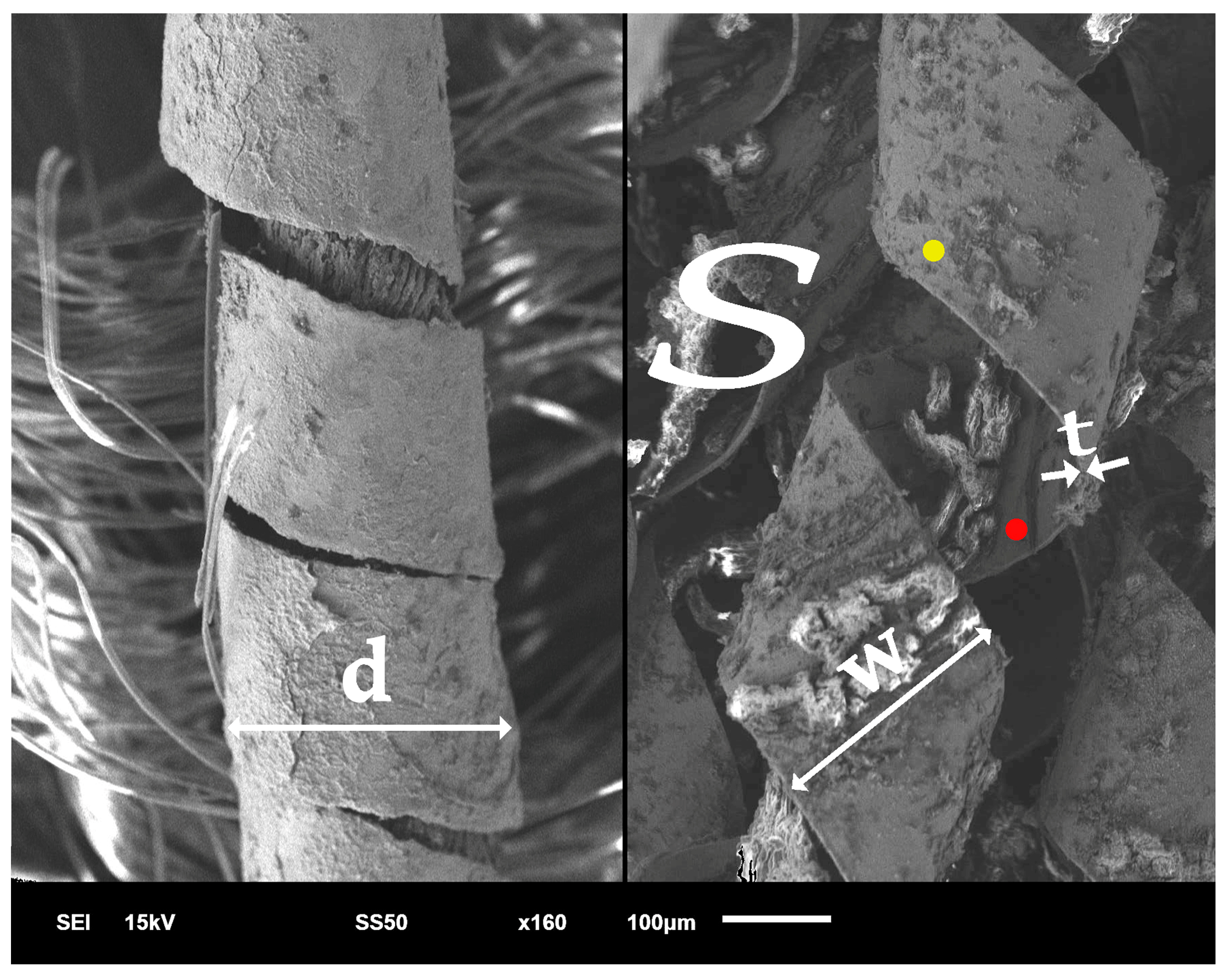


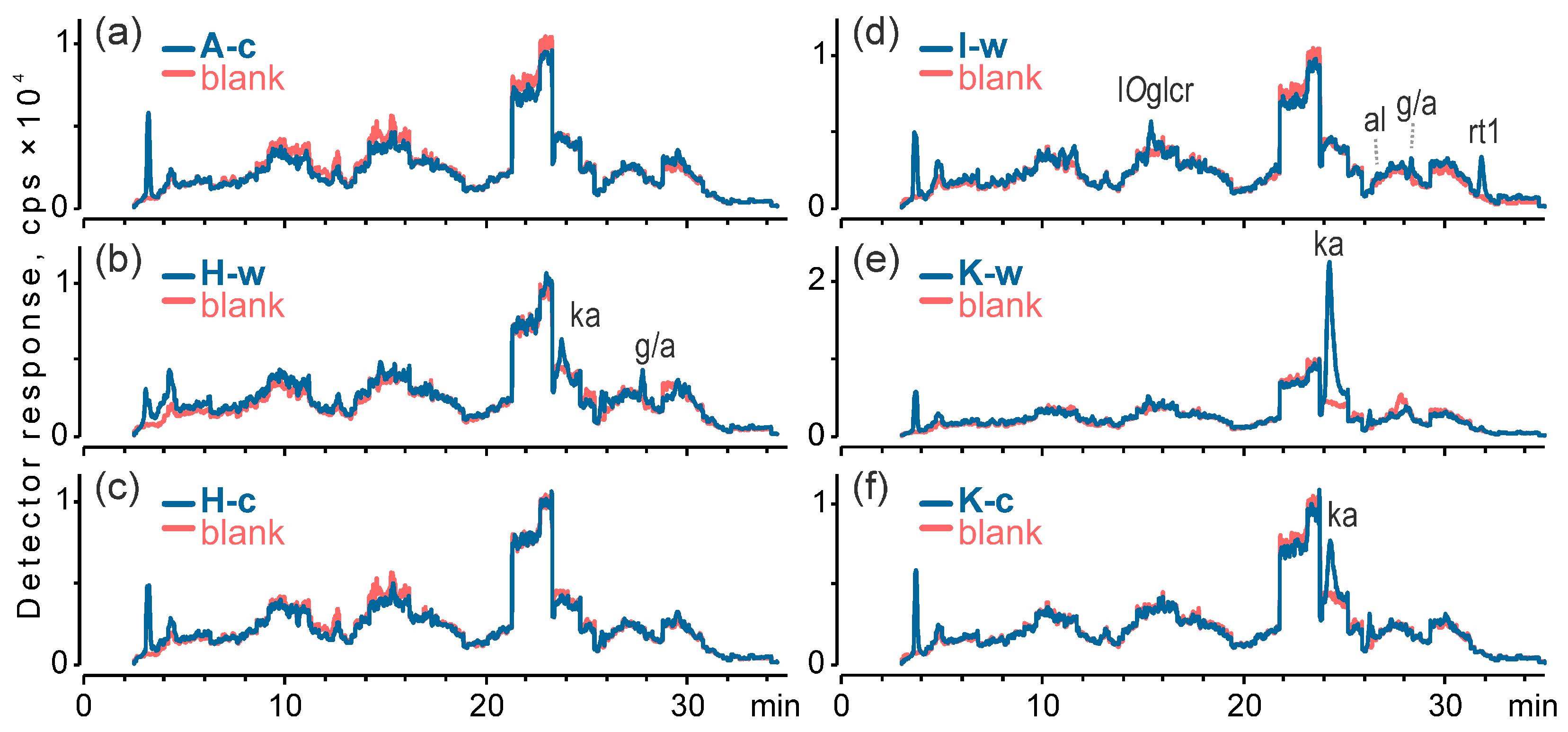


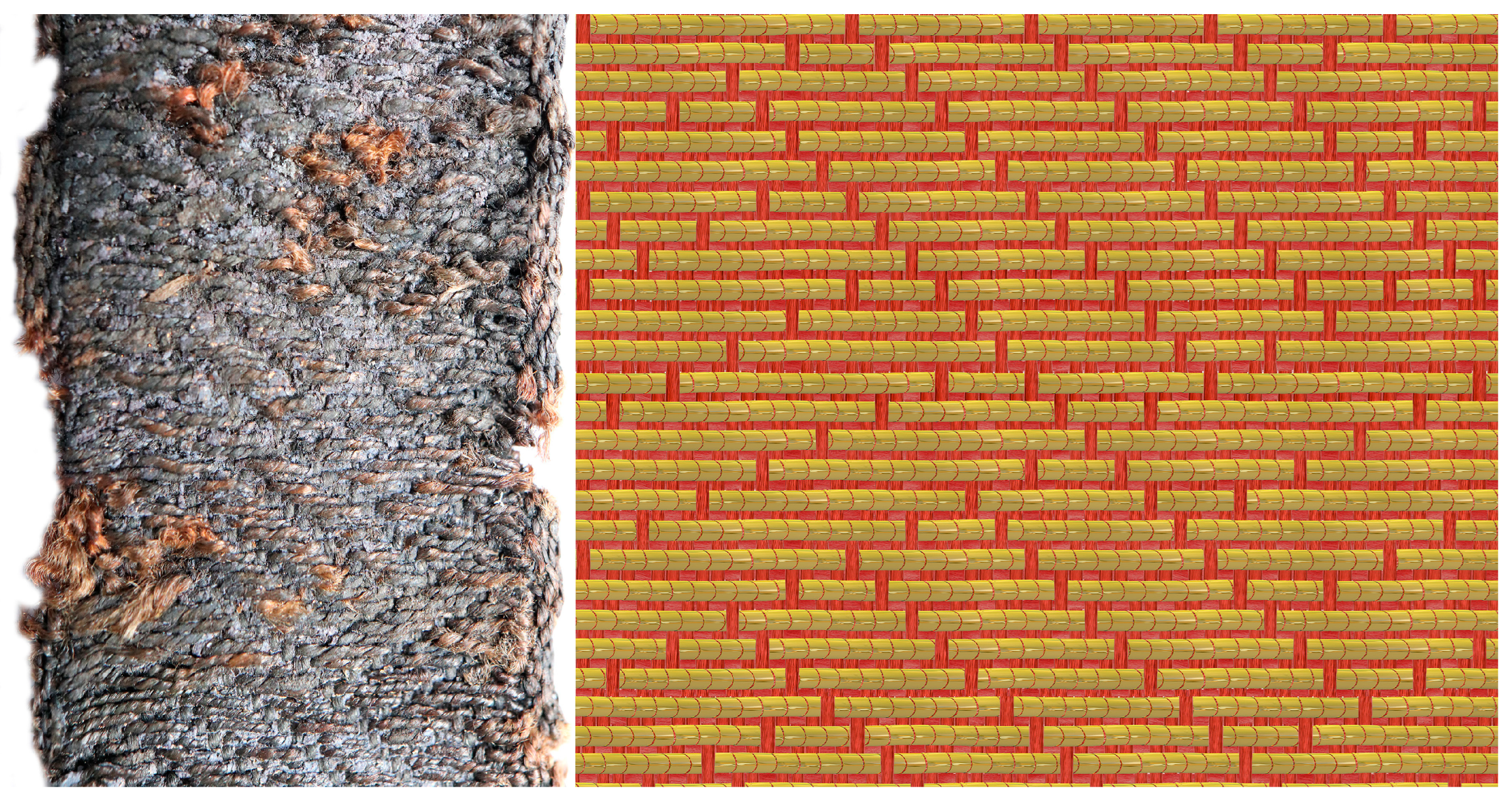
| Fabric Code | Visual Description of the Fabric | Inv. No | Grave | Gender |
|---|---|---|---|---|
| A | gold patterned with embroidery | Gródek 153/55 | 423 | female |
| B | gold unpatterned | Gródek 243a/55 | 466 | male |
| C | gold patterned | Gródek 130/55 | 416 | female |
| D | gold unpatterned | Gródek 94/55b | 389 | male |
| E | gold patterned | Gródek 152/55c | 421 | ? |
| F | gold patterned | Gródek 530/54 | 230 | male |
| G | gold unpatterned | Gródek 493/54 | 254 | ? |
| H | gold patterned | Gródek 195/53 | 80 | ? |
| I | gold patterned | Gródek 96/55a | 368 | female |
| J | gold patterned | Gródek 529/54 | 230 | male |
| K | gold patterned, tablet woven | Gródek 54/55 | 379 | male |
| L | gold patterned, tablet woven | Pień 35/07 B | 40 | child—male |
| Fabric Code | Measurement Points | Weight % | d mm | w mm | t μm | |||||
|---|---|---|---|---|---|---|---|---|---|---|
| Cl | S | Al | Fe | Ag | Au | |||||
| A | total | 6.10 | 8.31 | 10.03 | 3.51 | 58.90 | 13.15 | 0.22 | 0.18 | ---* |
| reverse | 5.45 | 13.78 | 14.44 | 25.21 | 41.12 | 0.00 | ||||
| B | total | 19.92 | 2.00 | 1.78 | 1.45 | 72.02 | 2.83 | 0.25 | 0.26 | ---* |
| reverse | 23.51 | 1.10 | 0.80 | 0.00 | 74.59 | 0.00 | ||||
| C | total | 0.76 | 0.00 | 1.03 | 0.71 | 27.67 | 69.83 | 0.33 | 0.31 | 11.00 |
| reverse | 6.22 | 0.00 | 9.33 | 8.44 | 76.00 | 0.00 | ||||
| D | total | 7.59 | 0.00 | 0.73 | 0.00 | 23.53 | 68.15 | 0.35 | 0.31 | 17.00 |
| reverse | 24.44 | 0.00 | 0.44 | 0.00 | 75.12 | 0.00 | ||||
| E | total | 15.77 | 0.43 | 0.71 | 0.38 | 47.80 | 34.91 | 0.21 | 0.24 | 10.00 |
| reverse | 20.47 | 0.00 | 4.72 | 0.00 | 74.80 | 0.00 | ||||
| F | total | 21.96 | 1.22 | 0.58 | 0.00 | 73.63 | 2.61 | 0.26 | 0.27 | ---* |
| reverse | 23.51 | 1.10 | 0.80 | 0.00 | 74.59 | 0.00 | ||||
| G | total | 19.50 | 0.90 | 0.65 | 0.21 | 62.52 | 16.23 | 0.31 | 0.31 | 12.00 |
| reverse | 15.39 | 4.94 | 0.61 | 0.00 | 79.05 | 0.00 | ||||
| H | total | 1.10 | 0.00 | 0.72 | 0.00 | 29.44 | 68.74 | 0.27 | 0.34 | 10.00 |
| reverse | 3.36 | 1.56 | 0.74 | 0.00 | 94.34 | 0.00 | ||||
| I | total | 6.29 | 0.12 | 2.22 | 0.73 | 31.07 | 59.57 | 0.38 | 0.30 | 9.00 |
| reverse | 9.92 | 5.69 | 13.77 | 7.89 | 62.74 | 0.00 | ||||
| J | total | 13.12 | 0.00 | 0.62 | 0.00 | 40.77 | 45.49 | 0.27 | 0.24 | 11.00 |
| reverse | 25.43 | 0.00 | 0.59 | 0.00 | 73.98 | 0.00 | ||||
| K | total | 11.55 | 5.01 | 4.31 | 7.93 | 61.99 | 9.21 | ---* | ---* | ---* |
| reverse | 15.04 | 0.33 | 1.79 | 18.20 | 64.64 | 0 | ||||
| L | total | 0.10 | 1.60 | 0.39 | 1.00 | 96.91 | 0.00 | 0.44 | 0.21 | 15.00 |
| reverse | 1.20 | 12.20 | 20.40 | 18.20 | 48.00 | 0.00 | ||||
| Fabric Code | Sample | Primary Compounds | Trace Compounds | Probable Dye | Colour |
|---|---|---|---|---|---|
| A | c | --- | --- | N/A | N/A |
| H | w | --- | kermesic acid, genkwanin/acacetin | kermes (Kermes vermilio Planchon) | red |
| H | c | --- | --- | N/A | N/A |
| K | w | rt1 (anthraquinone dimer) | alizarin, luteolin O-glucuronide, genkwanin/acacetin | madder specie (maybe Rubia tinctorum L.) + yellow flavonoid dye | red or orange |
| I | w | kermesic acid | --- | kermes (Kermes vermilio Planchon) | red |
| I | c | kermesic acid | --- | kermes (Kermes vermilio Planchon) | red |
| Lab No. ETH- | Fabric Code | Grave | Material | 14C Age ± 1σ (BP) | Calibrated Age (2σ Range; 95.4%) |
|---|---|---|---|---|---|
| 95953 | F | 230 | silk and gilded silver | 923 ± 25 | 1036–1203 CE |
| 95955 | I | 368 | silk and gilded silver | 877 ± 22 | 1052–1222 CE |
Disclaimer/Publisher’s Note: The statements, opinions and data contained in all publications are solely those of the individual author(s) and contributor(s) and not of MDPI and/or the editor(s). MDPI and/or the editor(s) disclaim responsibility for any injury to people or property resulting from any ideas, methods, instructions or products referred to in the content. |
© 2025 by the authors. Licensee MDPI, Basel, Switzerland. This article is an open access article distributed under the terms and conditions of the Creative Commons Attribution (CC BY) license (https://creativecommons.org/licenses/by/4.0/).
Share and Cite
Cybulska, M.; Lech, K.; Hajdas, I.; Sielski, J.; Wołoszyn, M.; Poliński, D. Material Analysis of Early Medieval Woven Bands from Gródek upon the Bug River and Pień, Poland. Materials 2025, 18, 5279. https://doi.org/10.3390/ma18235279
Cybulska M, Lech K, Hajdas I, Sielski J, Wołoszyn M, Poliński D. Material Analysis of Early Medieval Woven Bands from Gródek upon the Bug River and Pień, Poland. Materials. 2025; 18(23):5279. https://doi.org/10.3390/ma18235279
Chicago/Turabian StyleCybulska, Maria, Katarzyna Lech, Irka Hajdas, Jan Sielski, Marcin Wołoszyn, and Dariusz Poliński. 2025. "Material Analysis of Early Medieval Woven Bands from Gródek upon the Bug River and Pień, Poland" Materials 18, no. 23: 5279. https://doi.org/10.3390/ma18235279
APA StyleCybulska, M., Lech, K., Hajdas, I., Sielski, J., Wołoszyn, M., & Poliński, D. (2025). Material Analysis of Early Medieval Woven Bands from Gródek upon the Bug River and Pień, Poland. Materials, 18(23), 5279. https://doi.org/10.3390/ma18235279








